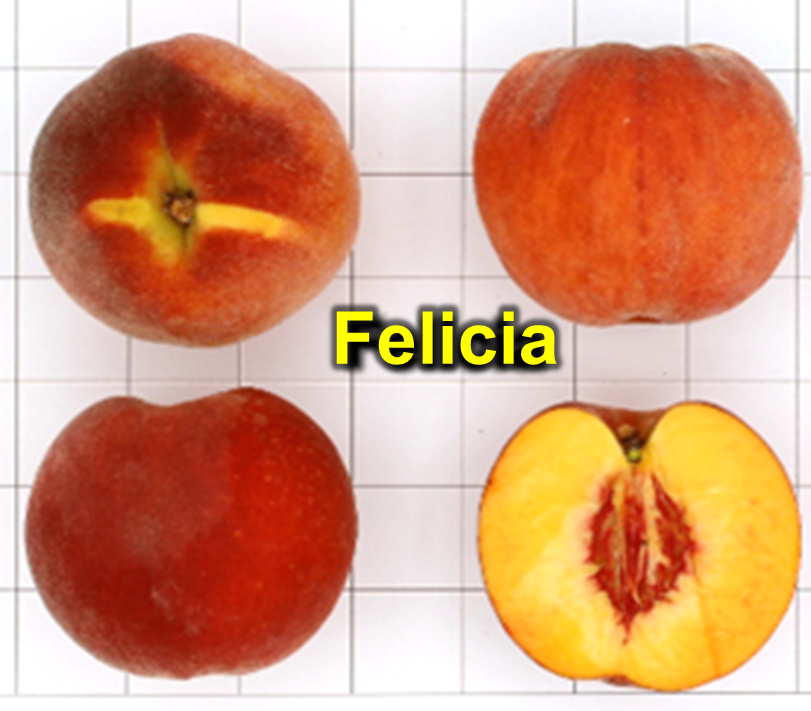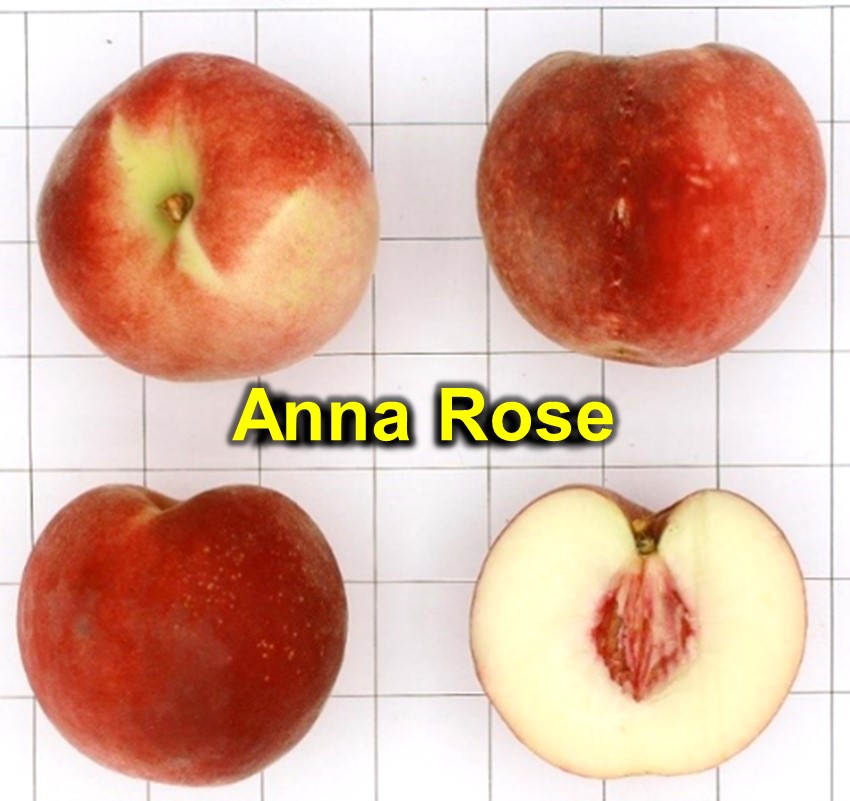 EVELYNN is a new, excellent, semi-free stone with a firm, yellow-fleshed peach variety. It is a low-acid, sweet to very sweet peach that ripens with Redhaven. Fruit is large, uniform, and has attractive, complete scarlet coloring, with smooth, low pubescence skin. It retains firmness on trees and during storage for longer than Redhaven, giving extra days for marketing the fruit. This variety is consistently productive and exhibits a low susceptibility to bacterial spot and split pits. Fruit skin doesn’t develop ‘inking’ even when it turns dark red. Bloom is generally delayed and extended, and, as a result, it produces a normal crop even in the frost years. Few varieties tick as many boxes as Evelynn. The fruit characteristics of Evelynn and other popular varieties in this season are compared in Table 1.
EVELYNN is a new, excellent, semi-free stone with a firm, yellow-fleshed peach variety. It is a low-acid, sweet to very sweet peach that ripens with Redhaven. Fruit is large, uniform, and has attractive, complete scarlet coloring, with smooth, low pubescence skin. It retains firmness on trees and during storage for longer than Redhaven, giving extra days for marketing the fruit. This variety is consistently productive and exhibits a low susceptibility to bacterial spot and split pits. Fruit skin doesn’t develop ‘inking’ even when it turns dark red. Bloom is generally delayed and extended, and, as a result, it produces a normal crop even in the frost years. Few varieties tick as many boxes as Evelynn. The fruit characteristics of Evelynn and other popular varieties in this season are compared in Table 1.
Challenge: Due to profuse bloom and high fruit set, moderate to heavy bloom or fruitlet thinning is always required to achieve greater fruit size. The cost of thinning could be higher compared to other varieties; however, it is a good problem. Consumers who strictly prefer traditional-flavored peaches may not like this sweet but sub-acid variety.

 REDHAVEN is still the standard of yellow-fleshed, semi-freestone peaches this season. A medium-large, globose to slightly ovate, 50-70% scarlet red over greenish-yellow ground color, yellow-fleshed, semi-freestone peach ripening from July 23-26. The flesh is firm, melting with good flavor. The moderately high sugar and acidity balance give it a tangy mouth feel. It requires multiple picks to complete the harvest. The tree is relatively hardy, vigorous, and productive, with low to moderate susceptibility to bacterial spot. It is also suggested for home orchard plantings.
REDHAVEN is still the standard of yellow-fleshed, semi-freestone peaches this season. A medium-large, globose to slightly ovate, 50-70% scarlet red over greenish-yellow ground color, yellow-fleshed, semi-freestone peach ripening from July 23-26. The flesh is firm, melting with good flavor. The moderately high sugar and acidity balance give it a tangy mouth feel. It requires multiple picks to complete the harvest. The tree is relatively hardy, vigorous, and productive, with low to moderate susceptibility to bacterial spot. It is also suggested for home orchard plantings.
Challenges: The fruit can get soft faster than the change of background color from greenish-yellow to yellow. Older blocks of Redhaven have been removed due to increased susceptibility to bacterial spot.
FELICIA is a recent release from Rutgers University; it is a very attractive freestone, yellow-fleshed peach variety. It has an attractive red to dark red skin and low pubescence, with traces of red in the flesh. It ripens a few days before Redhaven; however, unlike Redhaven, it retains firmness for longer while maintaining the balance of sweetness and acidity. Fruit is medium-large and firm-fleshed, which is essential for post-harvest handling. It has a low susceptibility to bacterial spots. If your consumers strictly prefer a traditional flavored peach, Felicia is considered a worthy replacement for Redhaven.
FLAMIN FURY PF# 9A-007 is a large to very large, yellow-fleshed, freestone, ripening a few days after Redhaven. The flesh is firm, retains firmness, and has a good acidic flavor. The tree is vigorous and productive, with low susceptibility to bacterial spots.
Challenges: It is susceptible to rusty spots. In some years, fruit gets softer before developing full red, and picking becomes challenging, especially with a new or unharvested crew. It has a prominent suture and fuzzy skin.
JOHN BOY is a large, globose, bright crimson red over a yellow-green ground color, yellow-fleshed, semi-freestone peach ripening approximately 3 days after Redhaven. The flesh is firm with a good, sweet, and tangy flavor and decent split pit resistance. The tree is similar to Loring; it is vigorous but more productive and consistently of good quality. John Boy is the standard all-around commercial variety in New Jersey this season. For enhanced fruit quality and color, one should wait till it gets a dark red burgundy color.
Challenges: Like Loring, the fruit has a prominent suture groove (see photo). It has a medium susceptibility to bacterial spot.
ANNA ROSE is a recently released attractive, uniform, round freestone, sweet sub-acid 90% red rose on white background white-fleshed peach variety that ripens a few days after Redhaven, and White Lady, and before Klondike. Fruit hangs well; in some years, its harvest can overlap with Klondike. It has excellent bud hardiness and a heavy fruit set. Tree vigor is high, with low bacterial spots on leaves and even less on fruits. Fruit gets sweeter, slightly bigger, and turns dark red if hung longer. It has consistently over-cropped with clean fruits—a worthy replacement for the Klondike or White Lady. Table 2 describes the fruit characteristics of Anna Rose, White Lady, and Klondike.
 WHITE LADY is a medium to large, semi-freestone, white-fleshed peach ripening approximately 5 days after Redhaven. The flesh is very firm with good to very good sub-acid flavor, sometimes aromatic. The tree is erect, vigorous, and moderately productive. White Lady is the standard of sub-acid white-fleshed peaches.
WHITE LADY is a medium to large, semi-freestone, white-fleshed peach ripening approximately 5 days after Redhaven. The flesh is very firm with good to very good sub-acid flavor, sometimes aromatic. The tree is erect, vigorous, and moderately productive. White Lady is the standard of sub-acid white-fleshed peaches.
Challenges: It has a medium susceptibility to bacterial spots. Skin can sometimes become discolored with abrasions and ink spots. Split pits are an occasional problem. It has a pronounced suture. It’s not as sweet as other white varieties but has good acidity.
KLONDIKE is an attractive, large to very large, globose, pink-purplish-red over a slightly cream-red ground color; white-fleshed, semi-freestone peach ripening late July, approximately a week days after Redhaven. The flesh is very firm with a very good, sweet, and low-acid flavor. The tree is vigorous and fair to moderately productive.
Challenges: Klondike is a pretty peach; however, in some years, flavor is lacking. Also, it is a bit bud-tender and moderately to highly susceptible to bacterial spot in some years.
Articles on the previous season Peach and Nectarine varieties
- Mid-July Nectarine varieties: https://plant-pest-advisory.rutgers.edu/mid-july-nectarine-varieties-for-nj-silvergem-silverglo-easternglo-and-avalon/
- Mid-July Peach varieties: https://plant-pest-advisory.rutgers.edu/mid-july-peach-varieties-gala-pf-8-ball-summer-serenade-july-rose-and-pf-lucky-13/
- Early July Peach Varieties: https://plant-pest-advisory.rutgers.edu/early-july-peach-varieties-sentry-glenglo-ruby-prince-garnet-beauty-and-sugar-may/
- Late June Peach Varieties: https://plant-pest-advisory.rutgers.edu/late-june-peach-varieties-for-new-jersey-new-and-standard/







